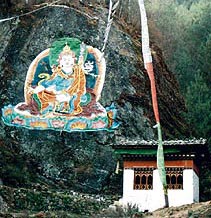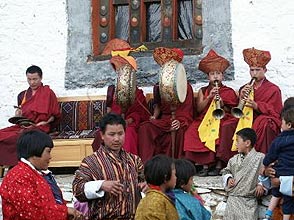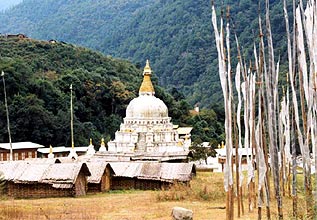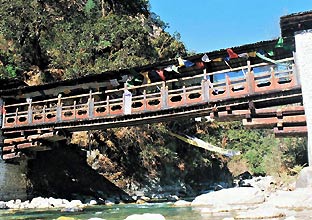 |
| Painting of Guru Rinpoche |
| Mani wall |
Just
as religious landmarks characterize the kingdom's history, the influence
of religion is highly visible in every day life of the lay population.
Bhutan is a spiritual nation.
|
 |
Hundreds
of sacred monasteries, stupas, religious institutions, prayer flags and
prayer wheels which dot the countryside provide a strong infrastructure
and atmosphere for the teachings of their living faith.
In
both urban and rural Bhutan, religious ceremonies and rituals are performed
regularly and with reverence. On auspicious days Bhutanese families make
pilgrimages to monasteries to offer prayers and butter lamps. The horoscope
of Bhutanese life is drawn from the scriptures. National and regional festivities,
coinciding with the seasons, are major events for the entire population
the year round. The Buddhist world, thus, regards the kingdom with spiritual
importance as the last bastion of Mahayana Buddhism. Earlier this century,
an ethnic Nepalese minority, settled in the southern regions of the country,
brought Hinduism, which is regarded in Bhutan as being closely related
to Buddhism.
 |
| Monks playing religious instruments |
Bhutanese
language and literature, the arts and crafts, ceremonies and events, and
basic social and cultural values draw their essence from religious teachings.
The tradition of fine art is alive today, manifested, for example, in products
like legendry Thangkas. The exquisite traditional painting is also visible
on monasteries and houses, skillfully enhancing the architecture.
|
Architecture
is also a significant feature of the Bhutanese identity. The combination
of engineering skill and aesthetic beauty is unparalleled in all structures,
from the massive monastic fortresses to houses and bridges. Traditional
shapes, colors and patterns on the walls, doors, windows, place Bhutanese
architecture in a class of it's own.
 |
 |
| Choeten
Kora |
Traditional
Wooden Cantilever Bridge |
|







